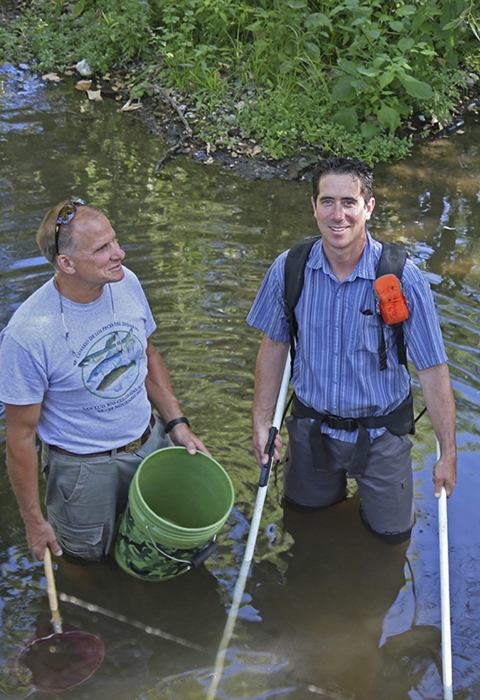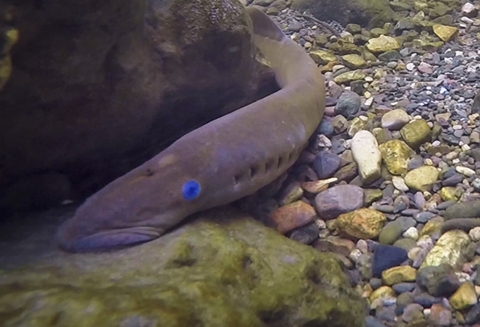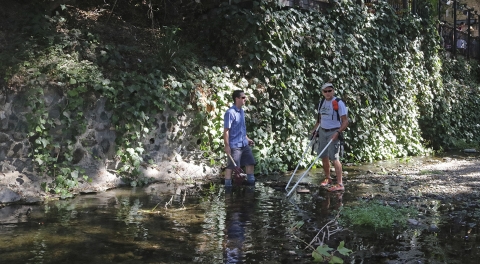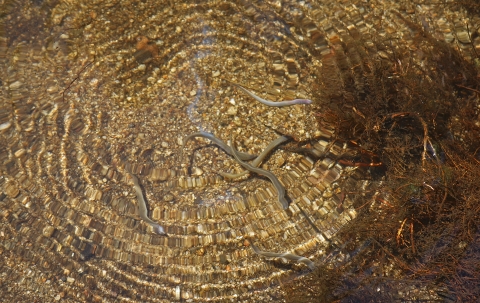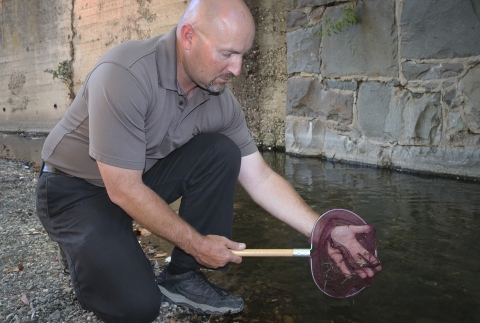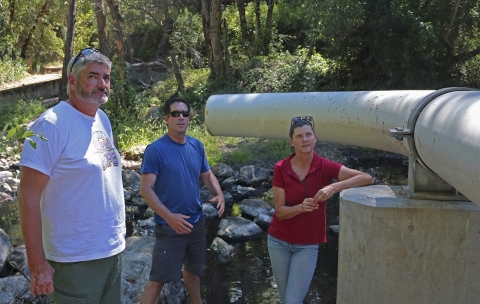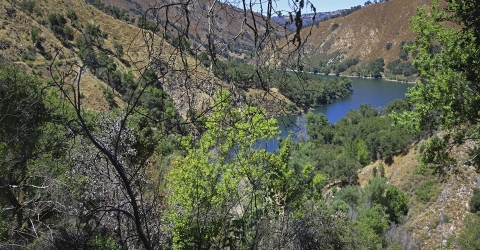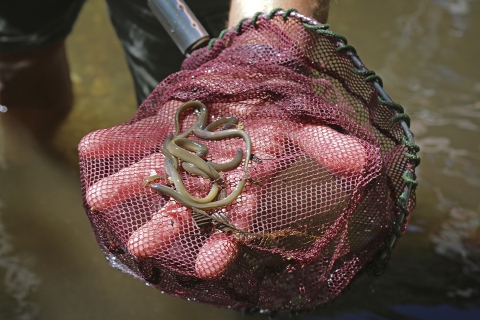“Ecstatic.” That’s the word to describe how Damon Goodman felt about the first ever recolonization of Pacific lamprey at the San Luis Obispo Creek and the first time since 1928 the same species was seen upstream of the San Clemente reach in the Carmel River.
2017 was a big year. Not only were lamprey confirmed back in the San Luis Obispo Creek, but the removal of the San Clemente Dam resulted in the species coming back to the lower portion of Carmel River (which was fully confirmed in July 2018).
Goodman, a U.S. Fish and Wildlife Service biologist with the Arcata office, has been working on solutions for Pacific lamprey in California for 14 years.
Along with Dr. Stewart Reid from Western Fishes, they work with partners including tribes throughout the state to restore the lamprey to their historical estuaries.
“Our boots have tasted nearly every anadromous stream connected to the Ocean from Canada to Mexico,” said Reid.
SAN LUIS OBISPO CREEK
In 2004, Reid and Goodman went to San Luis Obispo Creek and found lamprey abundant. Since, the species has not been confirmed south of San Luis Obispo, the pair believed this to be the southern-most substantial population in California where it existed.
Unfortunately on a trip back to the town one day in 2011, they were unable to find a single lamprey.
“We were shaken,” said Goodman of the absent lamprey. “We went back to show off abundant lamprey to our local stakeholders – provide evidence of how well the community was doing at supporting their native fishes, but instead we found the lamprey were completely absent. We went to site after site to the best locations and repeatedly there wasn’t any lamprey. We knew we had a major problem, but we didn’t know why.”
That question was answered when they discovered that a tidal weir and the bottom of the drainage had been modified in 2006 to make it easier for steelhead to pass - a restoration action designed for conservation of an endangered species, but failing to take into account lamprey. “You could not have designed a barrier better suited to exclude lampreys from the creek,” Goodman said of the weir.
Goodman and Reid along with City of San Luis Obispo biologist Freddy Otte set up a discussion and presentation open to the public at the library downtown in 2012. The room was packed with standing room only. “Out the back door,” said Reid. “We spoke of all the wonderful efforts the city had made but that they no longer had lamprey in their creek. Everyone’s face fell and they said ‘what can we do to make this right.”’
“Bringing local stakeholders together was the first step in solving the problem,” said Goodman. The San Luis Obispo Lamprey Working Group (includes California Department of Fish and Wildlife, San Luis Obispo Land Conservancy, Western Fishes, City of San Luis Obispo and U.S. Fish and Wildlife Service) was then established and the group’s mission was clear – return lamprey to San Luis Obispo Creek.
The working group’s first task was to resolve the problem that led to the extirpation, so they designed and installed a lamprey-specific passage route in 2013. Ultimately, the solution was a curved piece of metal (over the weir) known as a ‘lamp ramp’ that Reid bought at a salvage yard in Oregon and bent at a muffler shop. The total cost including metal, wood and bolts was only $314 and was constructed of primarily re-purposed materials.
Year after year the working group confirmed that lamprey were absent but continued to hold out hope. At one point, the group considered an active reintroduction effort, where lamprey would be brought in from a neighboring river. However, Javier Linares, a fish biologist at the Pacific Southwest Regional Office for the Service felt that was too aggressive as a strategy.
On St. Patrick’s Day in 2017, the dream was realized when adult Pacific lamprey were observed building nests in Mission Plaza. “Before we moved forward with reintroduction, they came back by themselves, saving time and money,” said Goodman. “We essentially facilitated a natural population expansion. What we learned from this effort will shape how we approach conservation measures across the range of the species.”
The mayor of San Luis Obispo was thrilled about the recolonization. “It’s exciting to see the native Pacific lamprey back in our local watershed due to all of the monitoring and stewardship efforts brought forward by the partnership between the United States Fish and Wildlife Service, California Department of Fish and Wildlife and the Natural Resources Protection Program in our Office of Sustainability,” said Mayor Heidi Harmon. “Our community cares deeply about San Luis Obispo Creek, and this wonderful news is further evidence that our efforts to protect and restore the creek are starting to pay off.”
“All it took was a piece of stainless steel and a couple of bolts,” said Dennis Michniuk, environmental scientist and district biologist with Region 4 of the California Department of Fish and Wildlife. “It was amazing that something so simple could solve such a large problem. It just shows that when you get people together they can come up with a low cost, low labor solutions.
“I never knew how integral to the ecosystem lamprey were until I went to that presentation in the library. I’m hooked now.”
Otte who is one of two city managers in the state with a natural resources program agreed. He believes lamprey make a huge difference as filter feeders to assist with the quality of the water from fecal issues due to pigeons.
“Here we are today continuing to do research in the natural resources program – having recolonized the lamprey; that’s a great feeling,” he said. “The lamprey are a great point of pride for San Luis Obispo. Once it was installed, low and behold a few years later they were back. It is good to tell this story of where we were to where we are now.”
“We thought Big Sur was the southernmost population in 2016, but the next year the world had changed which for a scientist is really cool,” said Reid.
The working group is designing a monitoring system to count Pacific Lamprey entering San Luis Obispo Creek, and they expect to install it later this year.
CARMEL RIVER, SAN CLEMENTE DAM
For over 100 years, Pacific lamprey have been absent upstream of the San Clemente Dam in the Carmel River. Built in 1921, the dam was removed in November 2015. By the first winter in 2016-2017, Pacific lamprey returned.
“We kept an eye out for them, knowing it was just a matter of time,” said Beverly Chaney, associate fisheries biologist with the Monterey Peninsula Water Management District. “When I saw the lamprey redds and carcasses I let them (Service) know right away. It is very exciting seeing the lamprey in an area they haven’t been in over 100 years.”
Chaney got a chance to learn more about Goodman and Reid’s efforts at Van Arsdale with the lamprey in 2017 while at the American Fisheries Society Conference in San Luis Obispo and was awestruck with their innovation - using low cost tubing to get lampreys over the dam.
“I was very impressed with that idea,” she said. “I thought it was fantastic – great solution.”
The finding at Carmel River was confirmed by Goodman, Reid and Michniuk on a warm summer day in July 2018.
“Our expectations are that we will see them,” said Goodman prior to their hike up to the river which was previously inaccessible due to the dam. The group was not disappointed as they discovered young lampreys almost immediately; providing some of the first evidence of successful reproduction above the dam.
While this success was celebrated, the challenge continues for Goodman and Reid with a goal of having lamprey back in all of the watersheds up and down the state where they once thrived.
Anyone who has seen a Pacific lamprey south of San Luis Obispo, please contact Damon Goodman at (707) 825-5155 or Damon_Goodman@fws.gov, or Stewart Reid at (541) 890-1669 or Westernfishes@opendoor.com.
